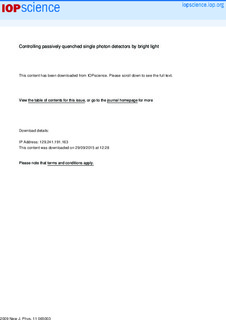| dc.contributor.author | Makarov, Vadim | |
| dc.date.accessioned | 2015-09-29T11:28:29Z | |
| dc.date.accessioned | 2015-10-15T11:28:16Z | |
| dc.date.available | 2015-09-29T11:28:29Z | |
| dc.date.available | 2015-10-15T11:28:16Z | |
| dc.date.issued | 2009 | |
| dc.identifier.citation | New Journal of Physics 2009, 11 | nb_NO |
| dc.identifier.issn | 1367-2630 | |
| dc.identifier.uri | http://hdl.handle.net/11250/2356233 | |
| dc.description.abstract | Single photon detectors (SPDs) based on passively quenched
avalanche photodiodes can be temporarily blinded by relatively bright light, of
intensity less than 1nW. A bright-light regime suitable for attacking a quantum
key distribution system containing such detectors is described in this paper. In
this regime, all SPDs in the receiver Bob are uniformly blinded by continuous
illumination coming from the eavesdropper Eve. When Eve needs a certain
detector in Bob to produce a click, she modifies the polarization (or other
parameters used to encode quantum states) of the light she sends to Bob such
that the target detector stops receiving light, while the other detector(s) continue
to be illuminated. The target detector regains single photon sensitivity and, when
Eve modifies the polarization again, produces a single click. Thus, Eve has
full control of Bob and can perform a successful intercept–resend attack. To
check the feasibility of the attack, three different models of passively quenched
detectors have been tested. In the experiment, I have simulated the intensity
diagrams the detectors would receive in a real QKD system under attack. Control
parameters and side effects are considered. It appears that the attack could be
practically possible. | nb_NO |
| dc.language.iso | eng | nb_NO |
| dc.publisher | IOP Publishing | nb_NO |
| dc.relation.uri | http://dx.doi.org/10%2E1088/1367-2630/11/6/065003 | |
| dc.title | Controlling passively quenched single photon detectors by bright light | nb_NO |
| dc.type | Journal article | nb_NO |
| dc.type | Peer reviewed | en_GB |
| dc.date.updated | 2015-09-29T11:28:29Z | |
| dc.source.volume | 11 | nb_NO |
| dc.source.journal | New Journal of Physics | nb_NO |
| dc.identifier.doi | 10.1088/1367-2630/11/6/065003 | |
| dc.identifier.cristin | 352939 | |
| dc.description.localcode | © IOP Publishing Ltd and Deutsche Physikalische Gesellschaft. Creative Commons Attribution License. | nb_NO |
